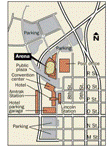Community and Regional Planning Program
Date of this Version
2015
Citation
Remote Sens. 2015, 7, 8757-8778; doi:10.3390/rs70708757
Abstract
The catastrophic 8.0 Richter magnitude earthquake that occurred on 12 May 2008 in Wenchuan, China caused extensive damage to vegetation due to widespread landslides and debris flows. In the past five years, the Chinese government has implemented a series of measures to restore the vegetation in the severely afflicted area. How is the vegetation recovering? It is necessary and important to evaluate the vegetation recovery effect in earthquake-stricken areas. Based on MODIS NDVI data from 2005 to 2013, the vegetation damage area was extracted by the quantified threshold detection method. The vegetation recovery rate after five years following the earthquake was evaluated with respect to counties, altitude, fault zones, earthquake intensity, soil texture and vegetation types, and assessed over time. We have proposed a new method to obtain the threshold with vegetation damage quantitatively, and have concluded that: (1) The threshold with vegetation damage was 13.47%, and 62.09% of the field points were located in the extracted damaged area; (2) The total vegetation damage area was 475,688 ha, which accounts for 14.34% of the study area and was primarily distributed in the central fault zone, the southwest mountainous areas and along rivers in the Midwest region of the study area; (3) Vegetation recovery in the damaged area was better in the northeast regions of the study area, and in the western portion of the Wenchuan-Maoxian fracture; vegetation recovery was better with increasing altitude; there is no obvious relationship between clay content in the topsoil and vegetation recovery; (4) Meadows recovered best and the worst recovery was in mixed coniferous broad-leaved forest; (5) 81,338 ha of vegetation in the damage area is currently undergoing degradation and the main vegetation types in the degradation area are coniferous forest (31.39%) and scrub (34.17%); (6) From 2009 to 2013, 41% has been restored to the level before the earthquake, 9% has not returned but 50% will continue to recover. The Chinese government usually requires five years as a period for post-disaster reconstruction. This paper could be regarded as a guidance for Chinese government departments, whereby additional investment is encouraged for vegetation recovery.


Comments
Copyright © 2015, the authors. Licensee MDPI, Basel, Switzerland. Open access, Creative Commons Attribution license 4.0.